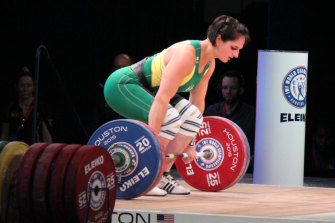‘They’d run a picture of me looking forlorn’: How a drug-cheat label sticks
Twelve years after she was found to have a banned substance in her system, Camilla Fogagnolo has developed a black humour around doping.
National strongwoman champion Camilla Fogagnolo. Credit:Kishka Jensen
The Tasmanian athlete has taken note of the explanations offered over the years, such as that of UFC heavyweight Frank Mir, who blamed eating kangaroo meat for testing positive for oral turinabol, and CrossFit athlete Emily Abbott, who claimed ibutamoren was in her system because she had kissed her partner (who had willingly taken the substance).
Then there was a race walker who said the nandrolone he was flagged for came from having oral sex with his pregnant wife. (He was cleared.)
Now there’s Australian swimmer Shayna Jack, who had been due to compete at the 2019 World Aquatics Championships, but was placed on immediate provisional suspension on July 12 when the Australian Sports Anti-Doping Authority (ASADA) revealed it had detected a prohibited substance in her system.
Jack has claimed ignorance as to how the muscle-growth agent Ligandrol had been ingested, but pointed out in a statement that it can be found in contaminated supplements.
And here, Fogagnolo has an unexpected stance. She herself remains steadfast that a contaminated supplement was responsible for the stimulant benzylpiperazine being in her system in 2007 when she was a 19-year-old weightlifter.
But, she says, she’s always suspicious when she hears that line.
“Swimming Australia has posted on its website that contaminated supplements are one of the biggest causes of positive doping cases. I don’t believe that. When someone gets caught, that’s just the safest thing to claim.”
In Fogagnolo’s case, the evidence seemed weighted in her favour. Benzylpiperazine was not a listed ingredient of Fortius Synephrine despite Australian products having to legally identify all substances, and Keith Murphy, the managing director of Fortius, admitted in a letter to the solicitor of weightlifter Jenna Myers – who tested positive at the same time as Fogagnolo – that “we believe that a batch was contaminated with BZP”.
Despite this, the ASADA still imposed a two-year sanction. “The clause they used basically states that an athlete is 100 per cent responsible for anything found within their system, and that ignorance is no excuse,” Fogagnolo says.
Camilla Fogagnolo competes at the 2015 IWF World Championships in Houston, Texas.
Like Jack, she’ll never forget the day she received the phone call from the ASADA, having been tested weeks earlier at the 2005 National U20 and Open Championships in Brisbane.
Fogagnolo was in the car park of a hardware store, having fruitlessly tried to persuade the owner to contribute a wheelbarrow to a meat raffle to send her to the Commonwealth Games trials in Melbourne.
“It was like being punched in the gut,” she says. “I got in the car, crying, and drove straight to my coach.”
Shayna Jack had initially pulled out of the championships for “personal reasons”, which sounds familiar to Fogagnolo. The initial legal advice she herself received was to keep quiet.
“I was told, ‘Don’t talk about it yet’,” she says. “ ‘You followed all the rules, it’s not steroids, it’s not testosterone, you’ll be OK. Let’s just keep training and see where it ends up’.”
But once word got out, Fogagnolo was shocked at how many friends she lost. “Mainly people were saying that I was stupid for having taken something and not knowing. It used to make me so angry because I thought, well what was I meant to do? I couldn’t afford to have everything tested – I was a penniless student, not a professional athlete.”
The consequences weren’t limited to gossip – the Tasmanian papers also had much to say.
“There was a big increase of interest in Australian weightlifting in that period,” she says, “and every time they did an article they’d use a caption along the lines of ‘disgraced local weightlifter’ and then a picture of me and maybe my coach, looking forlorn.”
As recently as May this year, a Tasmanian newspaper pulled a story on Fogagnolo’s performance at the Arnold’s Strongman Festival, where she won the lightweight women’s division and achieved a national record-breaking Atlas stone lift. The journalist texted Fogagnolo hours before the photo shoot to say that, upon learning about Fogagnolo’s suspension 12 years earlier, her editor was no longer interested.
In Fogagnolo’s view, three potential careers were kneecapped by her tarnished reputation.
She dropped out of university, where she had been studying health and physical education, as she surmised that a ‘drug cheat’ would have no hope of teaching at a high school.
Her recruitment processes to join the Federal Police and then the Tasmanian Police were similarly cut short after making good progress, which she believes is because her ban was made so public in the media.
Fogagnolo returned to competitive lifting in 2014 and represented Australia at the 2015 World Weightlifting Championships in Texas, also ranking highest in the country in her weight class. She retired in December 2017 due to injury, but in her 30s, took on two new pursuits: kettle bell sport and strongman.
In June 2019, she won her division of the Static Monsters World Championships, and in July competed at the Kettle Bell National Championships, winning the One Arm Long Cycle division, and two weeks later at the 2019 Australian Strongman Alliance Nationals, winning in her division and breaking the national female natural stone lift record.
Camilla Fogagnolo celebrates after winning the 2019 Arnold Sports Festival Strongwoman Championship. Credit:Sol Abdo
Kettle bell competitions are drug-tested, but strongman-style competitions are not. “I know this is an unpopular view, but at least if everything is untested you accept that people will or they won’t and that’s their choice,” says Fogagnolo. “I don’t condone drug taking, but I do believe that, at the elite level in all sports, a high percentage of the athletes aren’t clean.”
Fogagnolo thinks this is a timely reminder that the onus is on the athlete alone to be responsible for what they put in their bodies – something she does agree with the ASADA on.
“There are a few companies now that guarantee their product and have gone through testing regimes, and it says on their packaging that they are approved through the regulated agencies,” she says. “But if you’re an athlete and you’re worried – and you should be – just don’t take something. Companies want to sell their product and they’ll always find a way to give it more bang.”
Source: Read Full Article


